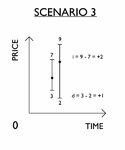PollyM
Active member
- Messages
- 195
- Likes
- 7
POST #1
Backtesting gets such a bad press, but care needs to be taken not to throw the baby out with the bathwater.
In principle, backtesting is a very useful tool. Most methods of calculation are, however, very questionable. At best, some backtesting methods will give you a very loose idea of potential outcomes, at worst they can be downright dangerous to a trader's financial health.
The purpose of this series of posts is to show reasons why backtesting can fail to deliver on its promise, including a discussion of one of its most insidious inhabitants ... Outside Days. This aspect is often overlooked, simply because it is adept at blending into the hills and valleys of the land named Price. Most abominable, yet I know it often rears its head without much notice being taken of it.
Once we take into consideration the above, together with typical trading costs, we can then make good inroads into developing a relatively simple backtest method using a spreadsheet, no bells and whistles needed to start, but very happy for you to then develop and modify to suit your own trading style.
Each of the following posts will be fairly short and sweet, and I'll do my best to keep up a decent rhythm. Thanks for looking in.
Backtesting gets such a bad press, but care needs to be taken not to throw the baby out with the bathwater.
In principle, backtesting is a very useful tool. Most methods of calculation are, however, very questionable. At best, some backtesting methods will give you a very loose idea of potential outcomes, at worst they can be downright dangerous to a trader's financial health.
The purpose of this series of posts is to show reasons why backtesting can fail to deliver on its promise, including a discussion of one of its most insidious inhabitants ... Outside Days. This aspect is often overlooked, simply because it is adept at blending into the hills and valleys of the land named Price. Most abominable, yet I know it often rears its head without much notice being taken of it.
Once we take into consideration the above, together with typical trading costs, we can then make good inroads into developing a relatively simple backtest method using a spreadsheet, no bells and whistles needed to start, but very happy for you to then develop and modify to suit your own trading style.
Each of the following posts will be fairly short and sweet, and I'll do my best to keep up a decent rhythm. Thanks for looking in.




